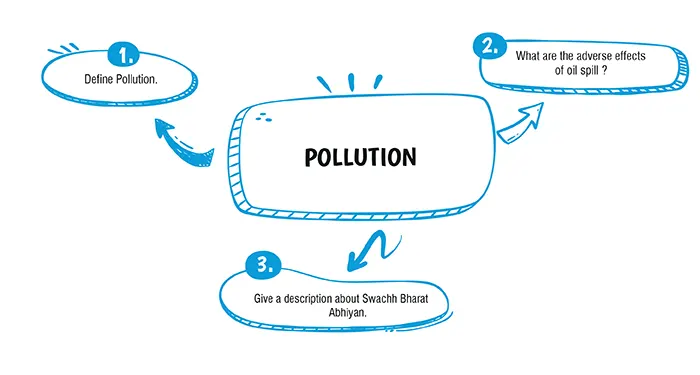

Here, you'll find important questions related to Chapter 14 Pollution For ICSE Class 10 Biology. These questions have been crafted to assist students in their preparation for the ICSE Class 10 Biology Examination in 2023–24. By practising various question types, students can clarify their doubts, enhance their exam readiness, boost their confidence, and refine their problem-solving skills
Pollution is an ever-growing concern in the modern world, posing significant threats to our environment, health, and well-being. It encompasses the introduction of harmful or toxic substances into the natural environment, leading to detrimental effects on air, water, soil, and all living organisms. In the study of biology, understanding pollution and its impact on ecosystems is crucial for students, forming an integral part of the Class 10 ICSE curriculum.In this exploration, we will delve into the multifaceted issue of pollution, examining its various types, causes, and consequences. Additionally, we will emphasise the importance of addressing important questions for Class 10 ICSE biology related to pollution. These questions play a vital role in equipping students with the knowledge and analytical skills necessary to comprehend the grave challenges posed by pollution and the urgent need for sustainable and eco-friendly practices.
Pollution refers to the introduction of harmful or undesirable substances into the natural environment, which can have detrimental effects on the environment, human health, and the well-being of other living organisms. These substances, known as pollutants, can be in the form of chemicals, physical agents, or biological contaminants, and they disrupt the natural balance and quality of air, water, and soil.
Key aspects of pollution include:
Pollution poses serious threats to the environment and human health, contributing to climate change, habitat destruction, and various health problems, including respiratory diseases and waterborne illnesses. It is a global issue that requires concerted efforts in the form of environmental regulations, sustainable practices, and public awareness to mitigate its impacts and protect the planet for future generations. Understanding pollution is a vital component of biology education, and addressing important questions related to pollution for Class 10 ICSE biology is crucial for building awareness and promoting responsible environmental stewardship.

Ans. (b) 65 HSU
Explanation:
Maximum permissible smoke density in diesel vehicles is 65 HSU.
Ans. (b)
Explanation:
Plants release oxygen in the air, hence, deforestation reduces trees which reduces oxygen levels of the air. Ultimately, CO2 and other gases will increase and cause pollution.
Explanation:
Pollution may be defined as “an undesirable change in the physical, chemical or biological characteristics of the air, water and land that can be harmful for health, survival or activities of human or other living organisms.
Explanation:
Replacement of coal by the oil fuel has increased the problem of pollution. The presence of oil in a water course is undesirable since it creates aesthetic problems. It has a tendency to spread over the surface of water due to which diffusion of oxygen into water is inhibited and re-aeration of water is affected.
Explanation:
Swachh Bharat Abhiyan is a national level campaign that aims to clean the streets, roads and infrastructure throughout the length and breadth of the country. This campaign was officially launched on 2 October, 2014 at Raj Ghat, New Delhi, by Prime Minister Narendra Modi. The campaign aims to achieve the vision of a ‘Clean India’ by 2 October, 2019. The major objective of the Swachh Bharat Abhiyan is to spread the awareness of cleanliness and the importance of it.The concept of Swachh Bharat Abhiyan is to provide basic sanitation facilities like toilets, solid and liquid waste disposal systems, village cleanliness, and safe and adequate drinking water supply to every person.


Pollution stands as one of the most pressing challenges of our time, with far-reaching consequences for our planet and all life it harbours.oswal.io offers a valuable resource in the form of a comprehensive collection of questions, aiding students in their preparation and deeper understanding of this crucial aspect of biology. By utilising such resources, students can empower themselves with the knowledge and awareness needed to address and mitigate the detrimental effects of pollution, ensuring a cleaner, healthier, and more sustainable future for all.
Ans: The main cause of air pollution is the burning of fossil fuels. Harmful gases like sulphur dioxide, carbon monoxide etc. are released into the atmosphere due to incomplete combustion of fossil fuels which pollutes the air.
Ans: Acid rain is the precipitation of acid in the form of rain. The harmful gases like nitrogen oxides and sulphur oxides are released into the atmosphere by burning of fossil fuels. These pollutants react with the rainwater and fall as acid rain.
Ans: Biological pollutants are mostly allergens that can cause hay fever, asthma, and other harmful allergic diseases.
Ans: Air pollution causes fumes, dust, mist, and smoke, which are called suspended particulate matter or SPM. It causes many respiratory problems and damages the lungs.
Ans: Water pollution can be caused by several pathogens, inorganic compounds, organic material, and macroscopic pollutants. Apart from these, point sources and nonpoint sources are also considered on the list of water pollution.